This day out had been planned for a couple of weeks. I’d heard from Gary about a Great British Rail sale which included a 95p ticket from Manchester to Sheffield. It seemed a good enough reason to venture back to Sheffield. Since I moved back to England I’d only been to Sheffield once – for a weekend’s uni music department reunion when I’d had a brief opportunity to see the changes in the city centre since I left uni. However when I surfaced in the morning it was pouring down. If I’d not booked the tickets in advance I wouldn’t even have considered venturing on a day’s excursion in such gloomy weather.

From Manchester Victoria we took the train to Piccadilly and crossed the road to visit Malmaison. My Hoyle ancestors who built Acre Mill in Old Town above Hebden Bridge ended up making it really, really big as textile manufacturers exporting goods worldwide. Their Manchester warehouse has since been converted into the Malmaison hotel and the bar looked welcoming for a morning coffee.
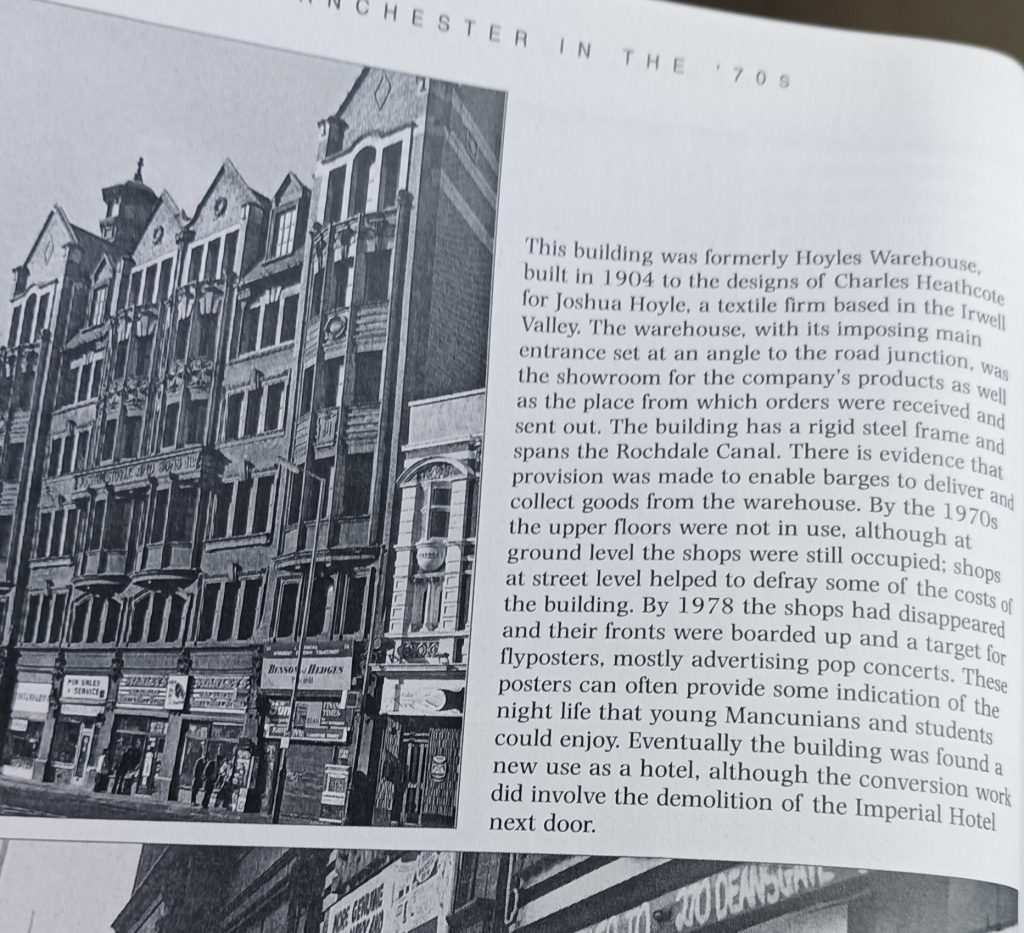
I had no idea that the facade of the ornate brick building would actually have Joshua Hoyle and Sons inscribed in stone facing Piccadilly station. I found out the cost of a night’s accommodation there. I really must stay there just to ‘feel the vibes’ of my ancestors!

Then it was onto the train for the hour’s journey to Sheffield. The train travels through the Hope Valley which I knew was very picturesque but the heavy clouds and poor light didn’t do much for the scenery. For three years I had travelled from Manchester to Sheffield but I don’t remember the train ride. I’m sure my focus wasn’t on the scenery. I don’t even recall the names of the stations and it’s possible that the trains I travelled on back then took a different route over the Woodhouse pass.
The first station of interest that we passed through was Marple. I could see posters on the platform about Agatha Christie. Wagatha Christie(!) is very much in the news at the moment. It’s the name that’s been given to the current celebrity scandal between two football wives – Wayne Rooney and Jamie Vardy. In fact their trial actual began today! Costs will be exceed 1 million pounds! But what of Marple’s connection to the real Agatha Christie? In July 2015, Mathew Prichard, grandson of the author and her closest living relative came to Marple and talked at the station about his family’s linkage to the area. He unveiled a blue plaque at the station that the Agatha Christie Ltd had kindly commissioned. This was done against the backdrop of artwork in the form of numerous Miss Marple book covers that had been specially produced by HarperCollins Publishers and now form a permanent addition at the station. Ah, these were the ‘posters’ I could see from the train. Agatha herself wrote the explanation of how her detective Miss Marple got her name. I expect you will be interested to learn that at the time I was writing The Thirteen Problems (starting with a series of 6 short stories for a magazine) I was staying with a sister of mine in Cheshire and we went to a sale at Marple Hall – the house alone, she said, was worth seeing, a beautiful old manor, belonging to the Bradshaws descended from Judge Bradshaw who sentenced Charles I. It was a very good sale with fine old Elizabethan and Jacobean furniture and at it I bought 2 Jacobean oak chairs which I still have – Wanting a name for my “old maid” character I called her Jane Marple. So now you know the answer to your question! Yours Sincerely Agatha Christie http://www.friendsofmarplestation.co.uk/agatha-christie.html
The next station to attract my attention was New Mills because almost adjacent to the station is the Torrs – a 70 ft deep gorge cutting through the sandstone. We were now in Derbyshire, close to the border with Cheshire. I could see a path running through the gorge and a bridge over the river that must have carved out its path through the sandstone. It certainly looked worth a visit.
https://www.bing.com/videos/search?q=The+Torrs+in+New+Mills&&view=detail&mid=6CC5CD0F8929B9D607306CC5CD0F8929B9D60730&&FORM=VRDGAR&ru=%2Fvideos%2Fsearch%3Fq%3DThe%2BTorrs%2Bin%2BNew%2BMills%26FORM%3DHDRSC3
By the time the train reached Chinley the landscape was becoming much more rugged and I truly felt as if I were now in the Peak District national park. Sheep with their lambs were sheltering from the drizzle behind stone walls and it certainly wasn’t bright enough to take photos from the train but we passed through Edale, the starting point of the Pennine way, passed through Hope station close to the Blue John caverns – which reminds me: I used to have a ring made out of Blue John stone, a semi precious stone only to be found in the depths of two caves at Castleton first hollowed out by the Romans two thousand years ago.

Then through Hathersage which I remember visiting from Sheffield to see Little John’s grave. Gary told me of a connection to Hathersage with Charlotte Bronte but I didn’t know of it. Apparently Hathersage became a familiar haunt of Charlotte’s and she often visited it in the company of her friend Ellen Nussey, since Ellen’s brother Henry had been made vicar of St. Michael’s church in Hathersage. He served in that position from 1845 until 1847, during which time Charlotte discovered the places, and people, who would be pivotal to the novel. The leading family in the Hathersage area at that time was the Eyre family. In the church, Charlotte would have seen the Eyre memorial, and in the graveyard she would have found the Eyre graves, including one for a Jane Eyre herself.
The train arrived in Sheffield on time. The station felt much bigger than what I remember and the forecourt has been completely rebuilt with fountains and a wonderful reflective steel wall – for this is Sheffield – city of steel. Looking up at the skyline I saw little of the immense changes that I see in Manchester and Leeds where lots of cranes are in evidence and much building work is in progress. The famous hole in the road has now been filled in!

As we wandered into town rather strange looking store frontage caught my eye with the signage – ‘Glory Holes – A golf club for adults only.’ The large windows opened onto a bar filled with odd figures . . . . It bills itself as ‘It is set to Sheffield’s ‘newest and raunchiest’ entertainment venue and bar. What can I say???
By this time there was lots of blue sky showing as we headed down towards the River Don and the canal. Situated between the two is Kelham Island, one of Sheffield’s oldest manufacturing sites. This manmade island was formed in the 1100s, when a stream was diverted to power a nearby mill. However, as industrial activity has moved on, the area has undergone a significant transformation in recent years and quietly become one of the most exciting parts of the city.
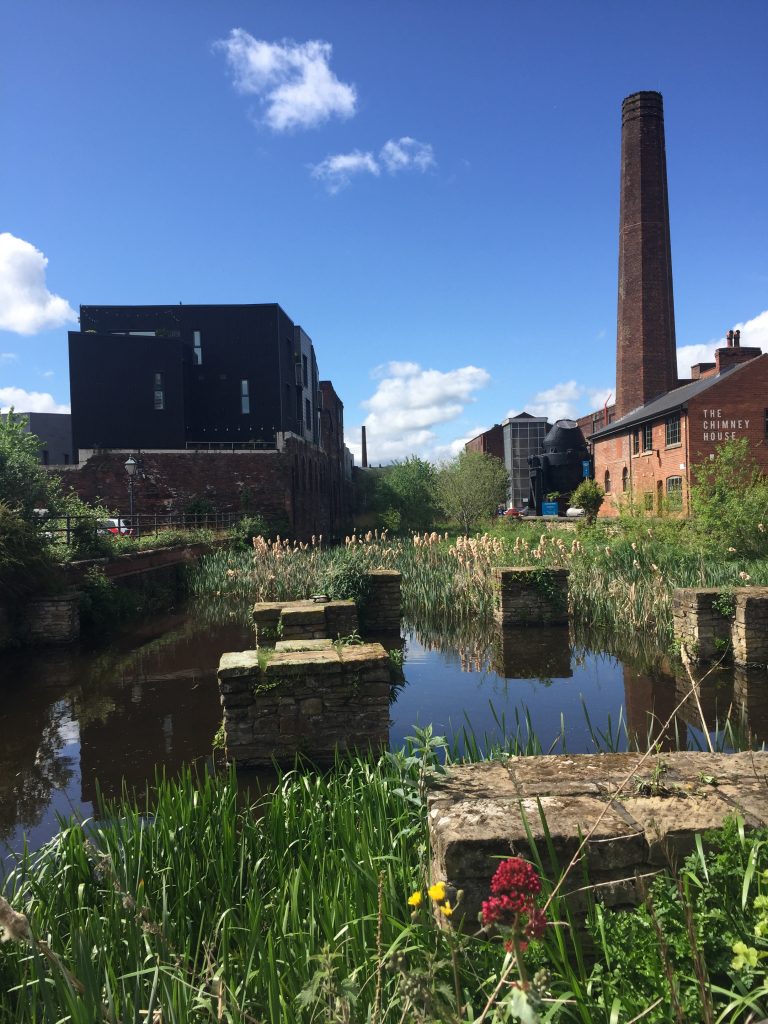
The remains of the numerous cutlery and steel works, factories and workshops is part of what gives the area its distinct charm, except nowadays these buildings house everything from indie shopping arcades to microbreweries and galleries.
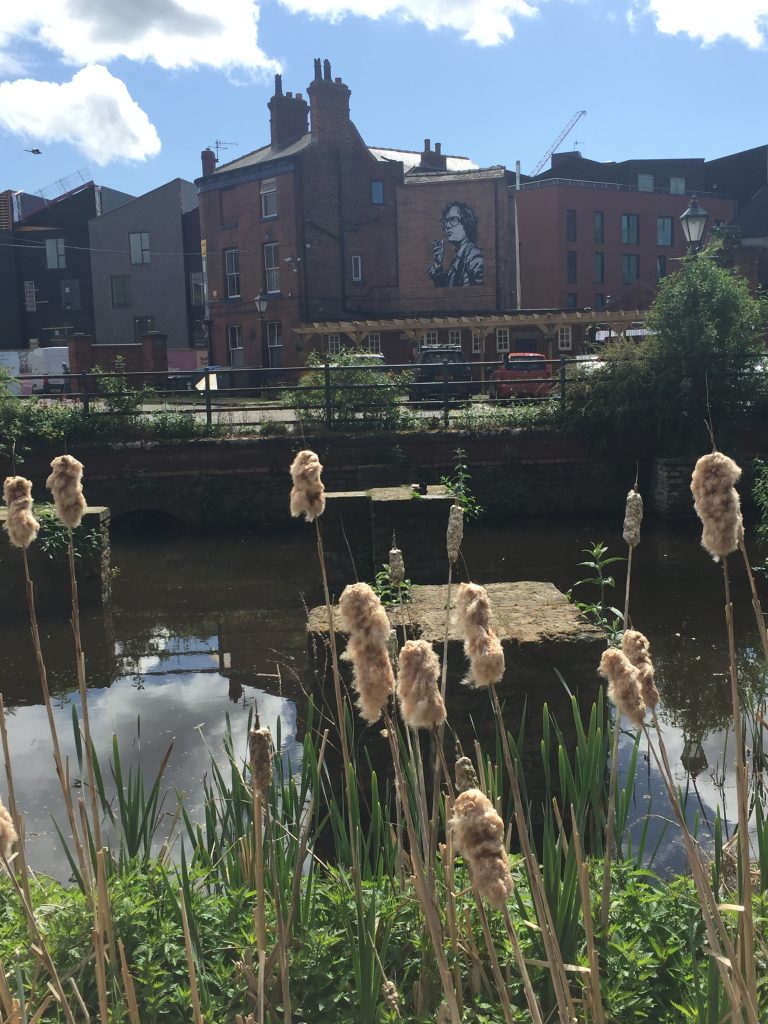



We selected the Fat Cat for lunch. As we entered I had the distinct feeling that I had stepped back in time 50 years. This felt like man’s pub and I fully expected it to be littered with elderly men sitting by themselves, ruminating over a pint or two. And yes, it was all men but I got talking to group of three on the next table simply by saying I liked the Geordie accent of one of their party. Doing my first teaching practice in Easington, just outside Durham I’d had a hard job figuring out what the children in my classes said to me. I had even more trouble holding down my conversation with this man but he knew Easington and what had happened to its community when the pits closed. The other two guys were from Sheffield and they knew each district I mentioned. What was wrong with saying I knew the Broomhill Tav?
Then on to Kelham Island museum, housed in a former steel factory. I had recently sent Michael a link to this place after he’d bought a set of cooking knives made in Sheffield and he wanted to find out more about the Sheffield steel industry. It tells the story of what it was like to live and work in Sheffield during the Industrial Revolution. There were some wonderful sculptures made from knives too.

Leaving the museum we wandered into the city centre where the Winter gardens, a vast greenhouse, takes pride of place in the open area close to the impressive town hall and the Crucible theatre where I enjoyed many plays a long time ago.

Back at the railway station it was feeling decidedly warm and we sat outside opposite the steel wall watching the commuters hurrying for their trains home.

The journey back was lovely. The sun was out in full and the glow of the early evening light made the hills look magical.

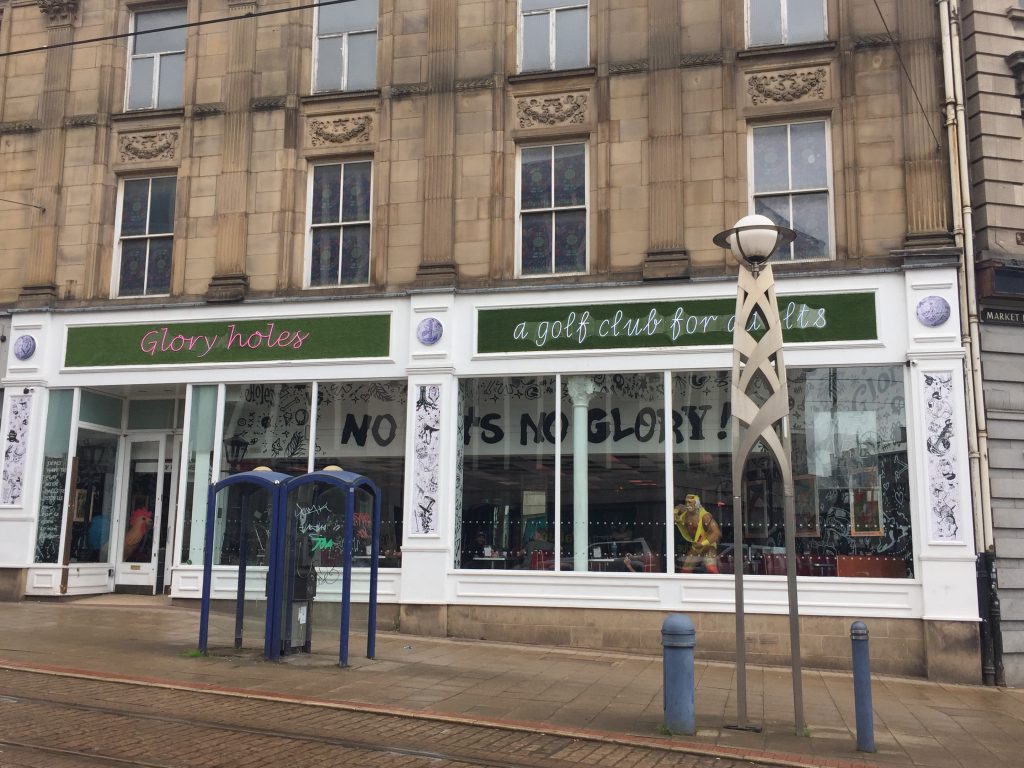





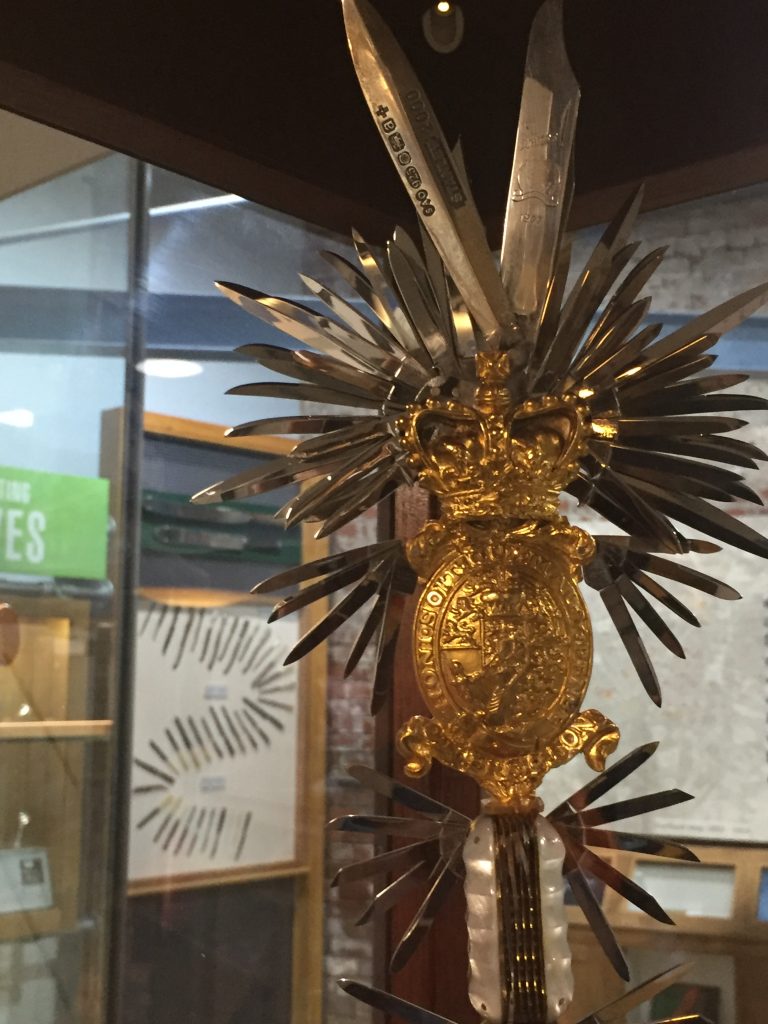

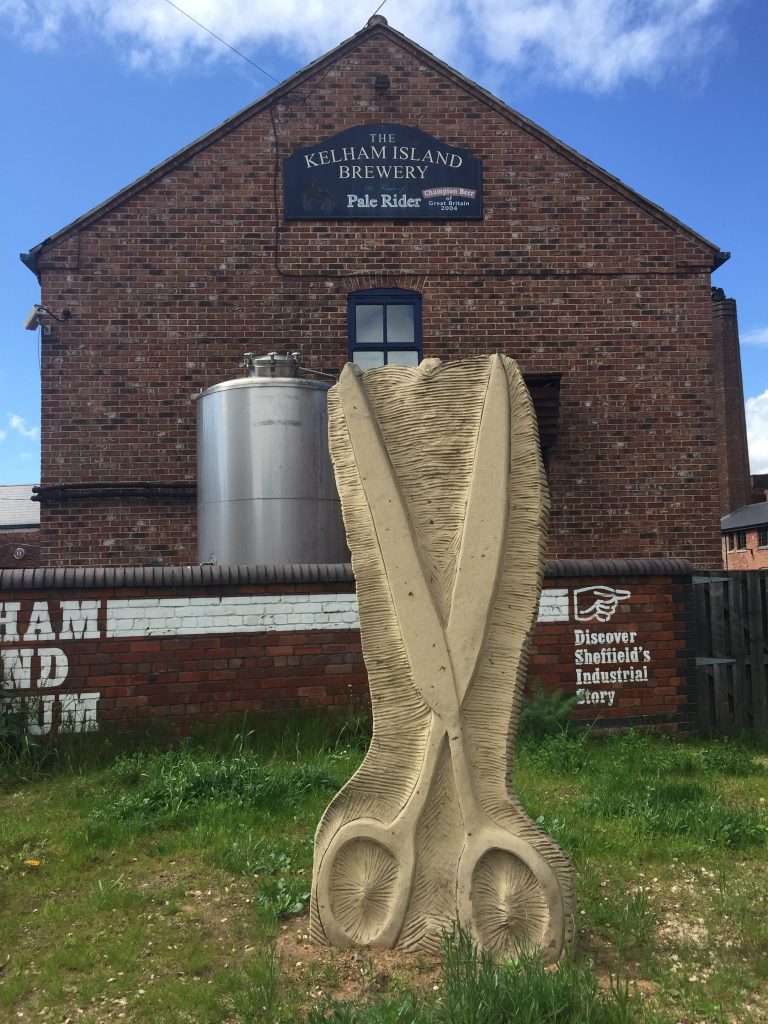
Wonderful blog Heather. If we made a decision on what to do based solely upon the weather, we would never go out!